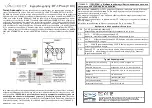
285
CHAPTER 19 INSTRUCTION SET
Preliminary User’s Manual U16035EJ1V0UM
19.1 Conventions
19.1.1 Operand identifiers and specification methods
Operands are written in “Operand” column of each instruction in accordance with the specification method of the
instruction operand identifier (refer to the assembler specifications for detail). When there are two or more methods,
select one of them. Alphabetic letters in capitals and symbols, #, !, $ and [ ] are key words and must be written as
they are. Each symbol has the following meaning.
• #: Immediate data specification
• !:
Absolute address specification
• $: Relative address specification
• [ ]: Indirect address specification
In the case of immediate data, describe an appropriate numeric value or a label. When using a label, be sure to
write the #, !, $, and [ ] symbols.
For operand register identifiers, r and rp, either function names (X, A, C, etc.) or absolute names (names in
parentheses in the table below, R0, R1, R2, etc.) can be used for specification.
Table 19-1. Operand Identifiers and Specification Methods
Identifier
Specification Method
r
X (R0), A (R1), C (R2), B (R3), E (R4), D (R5), L (R6), H (R7)
rp
AX (RP0), BC (RP1), DE (RP2), HL (RP3)
sfr
Special function register symbol
Note
sfrp
Special function register symbol (16-bit manipulatable register even addresses only)
Note
saddr
FE20H to FF1FH Immediate data or labels
saddrp
FE20H to FF1FH Immediate data or labels (even address only)
addr16
0000H to FFFFH Immediate data or labels
(only even addresses for 16-bit data transfer instructions)
addr11
0800H to 0FFFH Immediate data or labels
addr5
0040H to 007FH Immediate data or labels (even address only)
word
16-bit immediate data or label
byte
8-bit immediate data or label
bit
3-bit immediate data or label
RBn
RB0 to RB3
Note
Addresses from FFD0H to FFDFH cannot be accessed with these operands.
Remark
For special function register symbols, refer to
Table 3-5 Special Function Register List
.















































